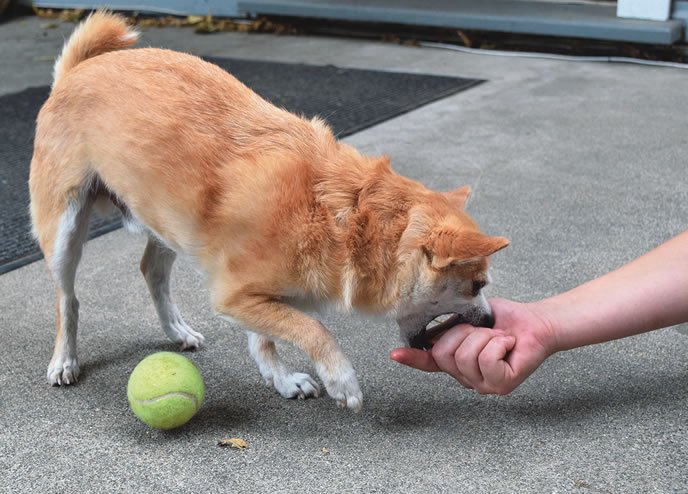
It’s important to be able to ask your dog to give something to you, especially something he is not supposed to have. If you take away only those things that are forbidden to him, he will learn to play the keep-away game, or worse, he may learn to resource-guard. If your dog already guards resources, you may need to do some behavior modification before it is safe to play the “trade” game with him. Ask a professional for help with this if you don’t think it’s safe.
To teach “Trade,” give your dog a toy or other object that he likes to play with. When he is happily playing, offer him a high-value treat. As he drops the toy to take the treat, say “Trade!” and click your clicker (or use a verbal marker, such as the word “Yes!”) and feed him the treat while you pick up the object with your other hand. Be sure to keep his mouth fully engaged with eating treats from your treat hand while you pick up the toy with the other. Then, give him back the toy or object. If he disengages from the treats, drop the toy and try again. By playing “Trade” with you, he will learn that he doesn’t lose the valuable object, but rather, gets something else good and gets his toy or chewie back.
It’s really important to maintain the same, happy, “We’re playing a game!” demeanor when you need to get something from him that he wasn’t supposed to have. Whether he has grabbed a package of rat poison or is playing with your grandmother’s antique lace doily, you will get the object back faster and with less damage by playing “trade” than if you go into panic mode and try to grab it from him. Of course, when you do this with a “forbidden object,” you won’t give it back to him, but that should happen so infrequently that he will learn to willingly give you things when you ask, instead of playing the keep-away game. You can also do this with higher-value items (such as stuffed Kongs and pig ears) as long as you can find a treat with a high-enough value to trade for. You may need to work up to trading him for the items that are of the highest value to him.
If your dog won’t give up the toy, do not try to push his nose away from it. You want him to give it up happily and voluntarily. Instead, drop a “Hansel and Gretel” trail of treats, with your treat hand at the end of the trail to keep him engaged while you pick up the toy with your other hand. Make sure that at no time you use threatening body posture or movements that make him defensive.




